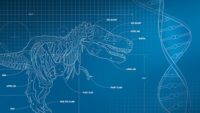By Ken Ham A news item caught our eye this week. It was reporting on a study which found that the bonnethead shark (a smaller relative of Hammerhead sharks) actually eats and digests seagrass. Now, scientists have noticed these sharks eating seagrass for several years but, perhaps influenced by their evolutionary worldview, had assumed they were just eating the seagrass to get at crabs, shrimp, or small fish living in and around the seagrass. But when researchers fed some captive bonnethead sharks a mostly seagrass diet, they noticed that the sharks did just fine. The researchers used Carbon-13 to label [More]
By Dr. Matthew E. Ingle How could large reef systems with many generations of coral have grown in the approximately 4,400 years since Noah’s Flood? …read more Source: AIG Daily
Someone said the three-pound human brain is the most complex and least-understood biological structure in the known universe. Scientific research regarding this incredibly intricate organ will never end. In fact, a fascinating new discovery in the field of human brain microanatomy was recently made. Scientists discovered a nerve cell called a rosehip neuron—so-called because of its bushy appearance.More… …read more Source: icr.org
Do ‘quill knobs’ indicate that some dinosaurs have feathers? …read more Source: creation.com
As every jigsaw enthusiast knows, getting every piece of the puzzle to fit in perfect juxtaposition with its neighbours doesn’t happen by itself. …read more Source: creation.com
By Dr. David Menton Did dinosaurs evolve into birds? Are the birds we see at our window actually feathered dinosaurs? For many evolutionists these claims are unassailable facts. …read more Source: AIG Daily
By Jeffrey P. Tomkins Results from this study negate the concept of the 98.5% DNA similarity myth and highlight the extremely flawed and humanized nature of the panTro4 version of the chimpanzee genome. …read more Source: AIG Daily
By Harry F. Sanders, III A study out of the University of Kent claims to have pieced together a portion of a dinosaur’s genome. This is a massive accomplishment—if their claim is true. …read more Source: AIG Daily
By Ken Ham The scientific community has been buzzing with the recent news that a small bone fragment recovered from a cave in Siberia is the remains of a 13-year-old girl whose parents belonged to what they call two different human species, Neanderthals and Denisovans. Her ancestry was revealed by a study of her mitochondrial DNA (from her mother) and her nuclear DNA (from both mother and father). The results showed her mother was a Neanderthal and her father a Denisovan. Now, is this surprising in a biblical worldview? Not at all. Neanderthals and Denisovans are not separate species, though [More]
By Buddy Davis What a nose! If you’ve ever seen a bloodhound at work, you can’t help but be impressed. …read more Source: AIG Daily
The scientific community continues to reel and exhibit bewilderment that well-preserved carbon-based (organic) fossil material regularly appears in sediments supposedly many millions of years old. One recent discovery of organic matrix is “evidence of exceptional preservation in the nacre and prismatic layers of a 66 Ma [million years] bivalve shell.”1 The mollusc shell in… More… …read more Source: icr.org
By Ken Ham According to a study of flowers trapped in amber, flowering plants had the same fragrant scents at the so-called “time of the dinosaurs” as many flowers today. …read more Source: AIG Daily
Deer show us that nearly any animal could become a carnivore … under the right conditions. …read more Source: creation.com
By Jean O’Micks Cephalopods, including octopuses, squids, cuttlefish, and nautiluses, are underrepresented in both genome sequencing projects as well as baraminology studies. …read more Source: AIG Daily
By Jeffrey P. Tomkins Have you ever woken up just before your alarm went off? It’s as if your body is wired with an internal clock. Actually, scientists have discovered trillions of them! …read more Source: AIG Daily
By John UpChurch Cleaning up dead animals really stinks—and that’s a good thing, which shows God’s wise provision even in a fallen world. …read more Source: AIG Daily
A recent Livescience article1 is entitled “The Galápagos Islands: Laboratory of Evolution.” It addresses, among other things, “unique examples of plant and animal life.” The islands contain a variety of biota (the animal and plant life in a particular area), such as the Galápagos giant tortoise, sea lions, the varieties of finches, waved albatrosses, penguins, marine iguanas, and hundreds of … More… …read more Source: icr.org
Biblical Creation predicts and requires rapid speciation! …read more Source: creation.com
By Dr. Ross Anderson While design may be seen in all living creatures, the early development of the fruit fly shows the making of a “simple” fruit fly exhibits forethought. …read more Source: AIG Daily
Australopiths are in the news again. …read more Source: creation.com
By Dr. Tommy Mitchell Your body produces toxic chemicals all day every day. Not to worry. Your liver’s got it covered. …read more Source: AIG Daily
Coffee has nutritional benefits! Scientists in Duesseldorf, Germany, report, Caffeine consumption has been associated with lower risks for multiple diseases, including type II diabetes, heart disease, and stroke…1 Coffee has nutritional benefit… More… …read more Source: icr.org
By Marvin Lubenow There are three lines of evidence demonstrating that the Neanderthals were fully human ancestors of modern humans in spite of their undeserved sordid reputation. …read more Source: AIG Daily
By Harry F. Sanders, III In the parable of the mustard seed, Jesus calls it the smallest seed. But was it really? Both evolutionists and old-earth creationists latch onto this parable. …read more Source: AIG Daily
According to the evolutionary story, humans evolved from an unidentified ape-like ancestor over two million years ago. But this story doesn’t line up with the Bible or scientific evidence. What can we learn from our DNA to decipher the origins debate? How does genetics support the Christian worldview of a recent creation? Listen: The Institute for Creation Research
In the battle to control pests with pesticides, things can change. …read more Source: creation.com
In the mid-1800s, a mild Augustinian friar named Gregor Mendel crossbred pea plants and pioneered the beginnings of understanding inherited traits. Genetics has come a long way since then. Neither Mendel nor Charles Darwin knew anything about the incredible molecule of life, DNA. Today, papers are published daily in science journals describing new discoveries of DNA’s role as a regulator and repairman. Scientists… More… …read more Source: icr.org












































